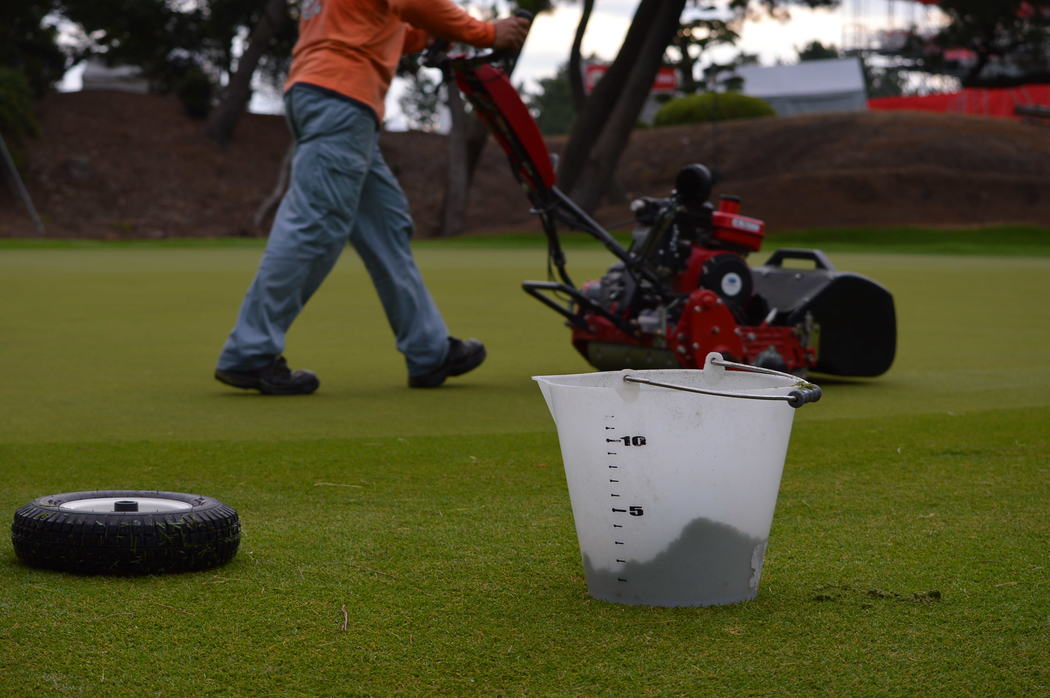Measuring and Managing Clippings During the COVID19 Crisis
The COVID19 crisis has forced us to think about our turf management in a new light. If there are no golfers, how much nitrogen should I apply? If I our crew size is limited, which management practices do we prioritize? Mowing eats up a lot of labor, how can we do that most efficiently? Do we need to control diseases on fairways? The questions go on and on. Below are some of my suggestions for dealing with this unusual situation.
Mow according to the one-third rule, not according to the calendar.
While this is one of the oldest rules of thumb in the book, recent research at University of Nebraska, University of Wisconsin, and Purdue University have confirmed that it holds true. When you mow more than one-third of the leaf blade off, the grass increases its growth rate. This is a hormone-induced stress response. When one-third or less of the leaf is mown, clipping yield is minimized. So instead of mowing fairways on Monday, Wednesday, and Friday, get out a Prism Gauge and mow your turf when it is 33% (that would be 0.180” for a green at 0.120”, 0.75” for a fairway at 0.50”, 4.5” for rough at 3”). Stripes don’t matter anymore, the growth rate does.
Increase the mowing height of your turf.
The overall length of your turf affects its growth rate. At UW-Madison, we measured the growth rate of bent/poa at putting green height vs. collar height. Surprisingly, we found the greens height grass grew 40% faster than the collar height. Because the leaf is a solar panel that feeds the rest of the plant, when the leaf area is small (low mowing height), the plant elicits a hormonal response to increase leaf area. I don’t recommend drastically changing mowing heights because of potential trouble in bringing them back down when normalcy returns, but increasing your mowing heights by 15 or 20% will slow the growth rate appreciably, and also result in deeper rooting and all the benefits that come with that.
Apply plant growth regulators.
Not only will PGRs reduce the growth rate of your grass to minimize mowing, they also afford some protection in the (unlikely) event that maintenance would be severely restricted or even banned. In a no-traffic or limited traffic situation, minimizing growth is less risky. In a reduced labor situation, the value of PGRs will become evident. If you are mowing based on the one-third rule, you’ll be able to see how much these tools can reduce your mowing requirements. I bet it will change the way you operate when things return to normal. Use the GreenKeeper Application which factors in your weather, grass species, and mowing height to give you the best, research-based re-application interval.
Eliminate or minimize nitrogen applications.
Your soil will provide enough nitrogen to keep the plant alive under no traffic. In my studies over the years, about half of the N in the turf comes from the soil, and the other half from fertilizer. Applying nitrogen will increase your growth rate, increase organic matter production, and is probably not required to maintain density and repair from the usual wear and tear that golfers induce. Sure, the turf will look a little more yellow than normal, but it’ll come right back with a little soluble N when you need it to.
Measure and record clipping volume.
If there is any silver lining to this crisis, it may be that superintendents will be a lot more invested in accurate estimates of turfgrass growth. In the last few years, progressive superintendents have been using clipping volume as a management decision tool. The adoption of clipping volume has so much in common with the adoption of soil moisture meters in the mid-2000s. I am still waiting to meet a golf course manager that started collecting clippings and then stopped because they felt it wasn’t worth the effort. The only difference between measuring clipping volume and measuring soil moisture is that measuring clipping volume is faster and less expensive than measuring soil moisture.
The first step is to find some graduated buckets. Then, dump your putting green clippings into the bucket. Tap the bucket on the ground twice firmly to settle the clippings and record the number of liters of clippings from each green. Enter the area of your putting greens and the volume of clippings from each green in a spreadsheet (Wisconsin Clipping Tracker Template) and you will quickly learn how your management influences your growth rate. In a typical scenario, 1 L of clippings per 100 m2 (same a 1 quart per 1000 ft2) would be tournament conditions, and 2 L/100m2 would be a good sustainable amount for daily play. In a no-traffic situation, 1 L/100m2 might be a good target to ensure that you have some growth, but you don’t have to worry about recovering from regular wear and tear. If/when Wisconsin opens courses to golfers, you’ll need to get that growth rate up into the 2 L/100m2 range. But these are just general guidelines, like for soil moisture, you’ll be able to identify the targets that work best for your course.
Good luck and best wishes to you during this difficult and unprecedented situation. I am happy to discuss these or any other topics with you (djsoldat@wisc.edu).
Image from Dr. Micah Woods.
